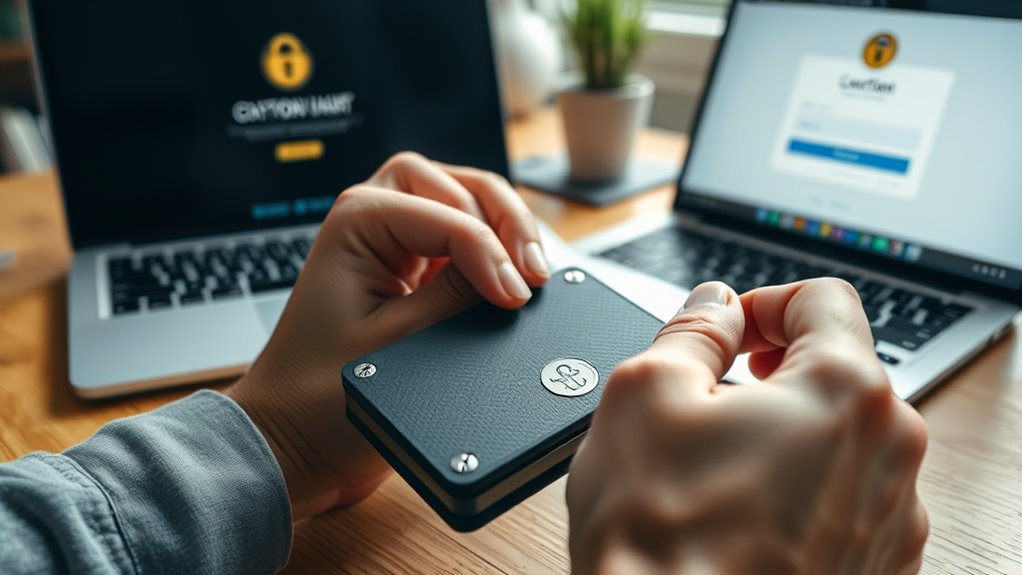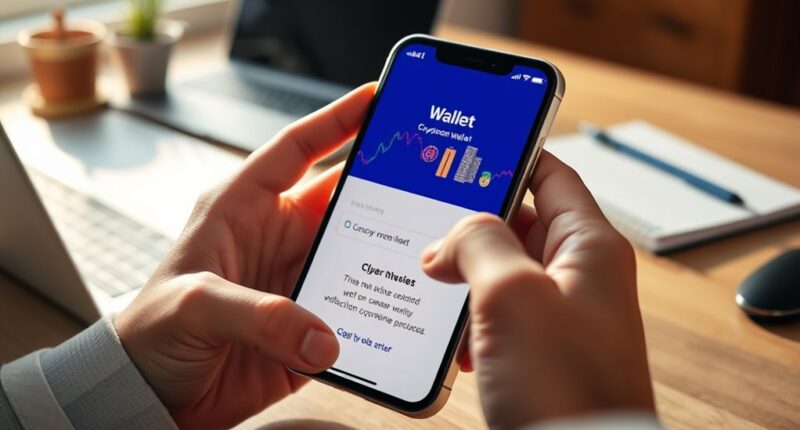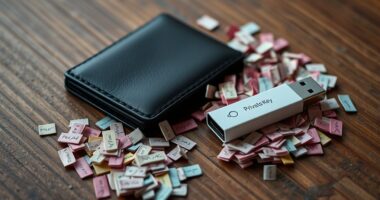When setting up your first crypto wallet, avoid rookie mistakes by choosing a reputable provider with strong security features like two-factor authentication and multi-signature support. Never share your private keys or recovery phrases, and keep them offline in a secure, physical location. Keep your device software updated and use strong, unique passwords. Be cautious of phishing scams and only download software from official sources. Staying vigilant guarantees your assets stay safe—continue to learn more about protecting your investments.
Key Takeaways
- Choose a reputable wallet with strong security features like two-factor authentication and multi-signature support.
- Never share your private keys or recovery phrases; store backup seed phrases securely offline.
- Keep your device software and wallet applications up to date with the latest security patches.
- Avoid digital storage of recovery phrases in cloud services or emails to prevent theft.
- Be cautious of phishing scams and verify software authenticity before installation.

Getting started with a crypto wallet is an essential step if you want to securely store and manage your digital assets. While the process might seem straightforward, it’s vital to pay attention to security best practices from the outset. Your wallet is the gateway to your cryptocurrencies, and safeguarding it means more than just choosing a reputable provider. You need to implement strategies that prevent theft or loss. First, always opt for wallets that offer robust security features, such as two-factor authentication and multi-signature support. These layers of security make it harder for someone to access your funds without your permission. Never share your private keys or recovery phrases with anyone, and be cautious about phishing attempts that try to trick you into revealing sensitive information.
Choose wallets with strong security features and never share your private keys or recovery phrases.
Another key aspect of setting up your wallet involves understanding wallet recovery methods. No matter how careful you are, mistakes happen—hardware failures, accidental deletion, or malware can compromise your wallet. That’s why you should familiarize yourself with the wallet recovery options available. Most wallets generate a recovery seed or phrase—usually 12 or 24 words—that acts as a master key to restore access if you lose your device or forget your password. Write this seed down on paper and store it securely offline, away from prying eyes or potential damage like fire or water. Never store recovery phrases digitally in cloud storage or send them via email, as these methods increase the risk of hacking.
Implementing security best practices also means keeping your device’s software up to date. Regular updates patch security vulnerabilities that could be exploited by cybercriminals. Use strong, unique passwords for your wallet and associated email accounts, and consider using a reputable password manager to organize them. If you opt for a hardware wallet, ensure it’s purchased from official sources to avoid counterfeit devices that may contain malicious firmware. When using software wallets, avoid downloading from untrusted sites, and always verify the authenticity of the software before installation. Additionally, understanding the importance of cryptocurrency security can help you stay vigilant against emerging threats.
Finally, stay informed about common scams and evolving security threats in the crypto space. Educate yourself on how to recognize phishing emails, fake websites, and social engineering tactics. By combining good security practices with a solid understanding of wallet recovery methods, you can substantially reduce the risk of losing your assets. Setting up your crypto wallet carefully from the start isn’t just about convenience; it’s about protecting your investments and ensuring peace of mind as you navigate the digital currency world.
Frequently Asked Questions
How Do I Choose the Best Crypto Wallet for Beginners?
When choosing the best crypto wallet for beginners, you want to prioritize wallet security and understand wallet types. Opt for a user-friendly option like a hardware or reputable software wallet that offers strong security features. Avoid complex wallets if you’re just starting out. Research different wallet types to find one that matches your needs, ensuring your funds stay safe while making transactions easy and accessible.
Can I Use Multiple Wallets Simultaneously?
Yes, you can use multiple wallets simultaneously for better wallet management and wallet customization. This approach helps you organize different assets, enhance security, and control access to your funds. Managing multiple wallets allows you to separate personal and trading accounts or store assets across various platforms. Just keep track of each wallet’s details and backup keys to avoid confusion or losing access, ensuring your crypto investments stay secure.
What Are Common Mistakes When Securing My Wallet?
When securing your wallet, avoid common mistakes like poor private key management and falling for phishing scams. Always store your private keys securely offline, never share them, and use strong, unique passwords. Be cautious of phishing attempts that try to steal your credentials—verify website URLs and avoid clicking suspicious links. These steps help prevent unauthorized access, keeping your crypto assets safe and ensuring you maintain control over your wallet.
Is It Safe to Store Large Amounts of Crypto in a Hot Wallet?
Storing large amounts of crypto in a hot wallet isn’t the safest move. Hot wallets are connected to the internet, making them more vulnerable to hacks. To guarantee wallet safety, follow security tips like enabling two-factor authentication and using strong passwords. For substantial holdings, consider transferring your funds to a cold wallet, which keeps your assets offline and considerably reduces risk. Always prioritize security tips to protect your investments effectively.
How Do I Recover My Wallet if I Lose My Device?
If you lose your device, you can recover your wallet by using your recovery seed. Make sure you’ve securely stored your device backup and recovery seed in a safe location. To restore your wallet, install the same wallet app on a new device and select the recovery option. Enter your recovery seed accurately, and your funds will be restored. Always keep your recovery seed private to prevent unauthorized access.
Conclusion
Getting started with your first crypto wallet is exciting, but watch out for common rookie mistakes. Double-check your private keys, use strong passwords, and choose reputable wallets. Don’t rush the setup process—take your time to secure everything properly. Remember, your crypto assets are valuable, so staying cautious now saves headaches later. Follow these tips, stay informed, and enjoy your journey into the crypto world with confidence and security.









